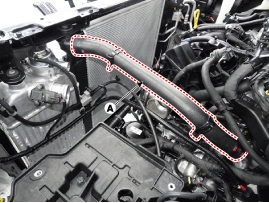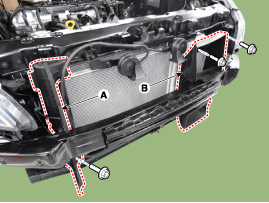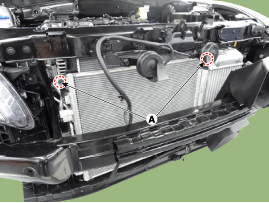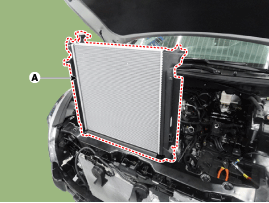Hyundai Sonata LF: Cooling System / Radiator Repair procedures
Hyundai Sonata LF 2014-2019 Service Manual / Engine Mechanical System / Cooling System / Radiator Repair procedures
| Removal and Installation |
| 1. |
Remove the cooling fan.
(Refer to Cooling System - "Cooling Fan") |
| 2. |
Loosen the drain plug, and drain the coolant. |
| 3. |
Remove the radiator cap to speed draining. |
| 4. |
Remove the radiator upper hose (A) and lowr hose (B).
|
| 5. |
Remove the radiator upper bracket bolts(A).
|
| 6. |
Disconnect the return hose(A).
|
| 7. |
Remove the air guard(A) and intercooler air guard(B).
|
| 8. |
Loosen the radiator mounting bolts(A)
|
| 9. |
Pull the radiator (A) upward and remove it from engine room.
|
| 10. |
Install in the reverse order of removal.
|
| Inspection |
Radiator Cap Testing
| 1. |
Remove the radiator cap, wet its seal with engine coolant, and then install it on a pressure tester.
|
| 2. |
Apply a pressure of 93.16~122.58kpa (0.95~1.25kg/cm?, 13.51~17.78psi). |
| 3. |
Check for a drop in pressure. |
| 4. |
If the pressure drops, replace the cap. |
Radiator Leakage Test
| 1. |
Wait until engine is cool, then carefully remove the radiator
cap and fill the radiator with engine coolant, then install a pressure
tester on it.
|
| 2. |
Apply a pressure of 93~123kPa (0.95~1.25kgf/cm?, 14~1
9psi). |
| 3. |
Inspect for engine coolant leaks and a drop in pressure. |
| 4. |
If the pressure drops, check hoses, the radiator and the
water pump for leakage. If there is no leakage, inspect the heater core,
the cylinder block and the cylinder head. |
| 5. |
Remove the tester and reinstall the radiator cap.
|
Categories
- Manuals Home
- Hyundai Sonata Owners Manual
- Hyundai Sonata Service Manual
- Body Electrical System
- Audio
- Starting System
- New on site
- Most important about car
Copyright © 2025 www.hsonatalf.org












